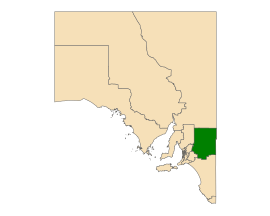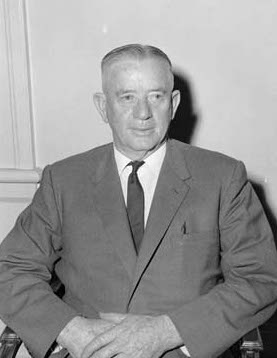
Francis Henry Walsh was the 34th Premier of South Australia from 10 March 1965 to 1 June 1967, representing the South Australian Branch of the Australian Labor Party.

Flinders is a single-member electoral district for the South Australian House of Assembly. It is named after explorer Matthew Flinders, who was responsible for charting most of the state's coastline. It is a 58,901 km² coastal rural electorate encompassing the Eyre Peninsula and the coast along the Nullarbor Plain, based in and around the city of Port Lincoln and contains the District Councils of Ceduna, Cleve, Elliston, Lower Eyre Peninsula, Streaky Bay and Wudinna; as well as the localities of Fowlers Bay, Nullarbor and Yalata in the Pastoral Unincorporated Area. The seat was expanded in 2002 to include a western strip of land all the way to the Western Australia border.

Adelaide is a single-member electoral district for the South Australian House of Assembly. The 22.8 km² state seat of Adelaide currently consists of the Adelaide city centre including North Adelaide and suburbs to the inner north and inner north east: Collinswood, Fitzroy, Gilberton, Medindie, Medindie Gardens, Ovingham, Thorngate, Walkerville, most of Prospect, and part of Nailsworth. The federal division of Adelaide covers the state seat of Adelaide and additional suburbs in each direction.
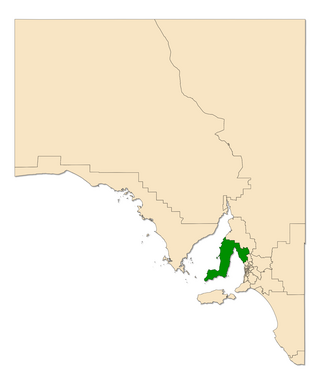
Goyder was an electoral district of the South Australian House of Assembly. It was a 9,258 km² rural electorate located on the Yorke Peninsula and taking in the towns of Ardrossan, Bute, Edithburgh, Kadina, Maitland, Minlaton, Moonta, Port Wakefield, Wallaroo and Yorketown. The electorate was named after George Goyder, a former state Surveyor-General famous for developing Goyder's Line, which indicated the area of the state that had enough rainfall to be suitable for agriculture.
Karlene Ann Maywald is an Australian National Party politician who represented the seat of Chaffey in the South Australian House of Assembly from October 1997 until March 2010. Her election to the South Australian Parliament made her leader of the South Australian Nationals and made her the first woman to lead a branch of the party at the state or federal level. During her tenure, from 2004 until 2010, she was the Minister for the River Murray and Minister for Water Security in the Rann Labor government. She is currently the Chair of the National Water Commission and a Director of SA Water, as well as Managing Director of Maywald Consultants Pty Ltd.
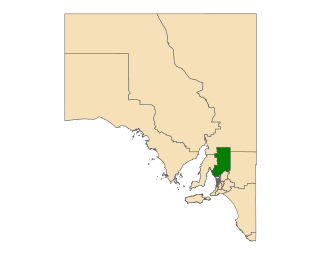
Frome is a single-member electoral district for the South Australian House of Assembly. It is named after Edward Charles Frome, the third surveyor-general of South Australia. The electorate stretches north-eastwards from the Gawler River and Gulf St Vincent in the south, and includes many of the agricultural areas of the Clare and Gilbert Valleys. It covers a total of 12,921 km2 (4,989 sq mi) and takes in the towns of Auburn, Clare, Mintaro, Port Broughton, Saddleworth, Snowtown and Riverton. Prior to the 2020 redistribution, its main population centre was Port Pirie, since transferred to Stuart.

Light is a single-member electoral district for the South Australian House of Assembly. Light is named after Colonel William Light, who was the first Surveyor-General of South Australia. The electorate was created in 1857, abolished at the 1902 election and recreated at the 1938 election. It is based on the semi-rural township of Gawler, and stretches southwards into the outermost northern suburbs of Adelaide.
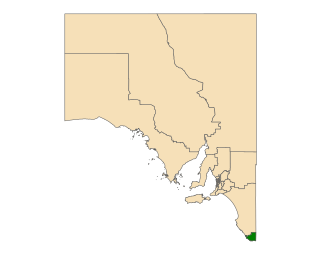
Mount Gambier is a single-member electoral district for the South Australian House of Assembly. It covers the far south-east corner of the state containing the City of Mount Gambier and District Council of Grant local government areas. It is centred on the city and extinct volcano of Mount Gambier.

Mawson is a single-member electoral district for the South Australian House of Assembly. It covers the entirety of Kangaroo Island, and parts of the local government areas of Alexandrina Council, the City of Onkaparinga, and the District Council of Yankalilla. Major localities in the district include Cape Jervis, Kingscote, McLaren Vale, Port Willunga, Sellicks Beach, Willunga and Yankalilla.

Unley is a single-member electoral district for the South Australian House of Assembly. Named after the suburb of the same name, it is the state's smallest electorate by area at just 14.1 km2 (5.4 sq mi). It is a suburban electorate in Adelaide's inner south, taking in the suburbs of Eastwood, Frewville, Fullarton, Glenside, Glenunga, Goodwood, Highgate, Hyde Park, Kings Park, Malvern, Myrtle Bank, Parkside, Unley, Unley Park and Wayville, as well as parts of Glen Osmond and Millswood.
The Playmander was a pro-rural electoral malapportionment in the Australian state of South Australia, which was introduced by the incumbent Liberal and Country League (LCL) government in 1936, and remained in place for 32 years until 1968.

The National Party of Australia (S.A.) Inc. is a political party in South Australia, and an affiliated state party of the National Party of Australia. Like the National Party of Western Australia, it is an independent party and not part of the Liberal/National Coalition. First contesting the 1965 state election, the party has held two South Australian House of Assembly seats at alternating periods; Peter Blacker (1973–1993) in Flinders and Karlene Maywald (1997–2010) in Chaffey.

State elections were held in South Australia on 12 July 1975. All 47 seats in the South Australian House of Assembly were up for election. The incumbent Australian Labor Party led by Premier of South Australia Don Dunstan won a third term in government, defeating the Liberal Party of Australia led by Leader of the Opposition Bruce Eastick.

The 1968South AustralianState election was held in South Australia on 2 March 1968. All 39 seats in the South Australian House of Assembly were up for election; 38 of the 39 contests were won by candidates from Australia's two major political parties. The incumbent Labor Party South Australia led by Premier of South Australia Don Dunstan and the Liberal and Country League led by Leader of the Opposition Steele Hall) both won 19 seats. The sole independent candidate to win a race, Tom Stott of the Ridley electorate, joined with the LCL's 19 seats to form a coalition government that held a 20 to 19 majority, thus defeating the Dunstan Labor government.

State elections were held in South Australia on 6 March 1965. All 39 seats in the South Australian House of Assembly were up for election. The incumbent Liberal and Country League led by Premier of South Australia Thomas Playford IV, in power since 1938, was defeated by the Australian Labor Party led by Leader of the Opposition Frank Walsh.

State elections were held in South Australia on 3 March 1962. All 39 seats in the South Australian House of Assembly were up for election. The incumbent Liberal and Country League led by Premier of South Australia Thomas Playford IV defeated the Australian Labor Party led by Leader of the Opposition Frank Walsh.

State elections were held in South Australia on 3 March 1956. All 39 seats in the South Australian House of Assembly were up for election. The incumbent Liberal and Country League led by Premier of South Australia Thomas Playford IV defeated the Australian Labor Party led by Leader of the Opposition Mick O'Halloran.

State elections were held in South Australia on 19 March 1938. All 39 seats in the South Australian House of Assembly were up for election. The incumbent Liberal and Country League government led by Premier of South Australia Richard L. Butler defeated the opposition Australian Labor Party led by Leader of the Opposition Andrew Lacey.

The 2014 South Australian state election elected members to the 53rd Parliament of South Australia on 15 March 2014, to fill all 47 seats in the House of Assembly and 11 of 22 seats in the Legislative Council. The 12-year-incumbent Australian Labor Party (SA) government, led by Premier Jay Weatherill, won its fourth consecutive four-year term in government, a record 16 years of Labor government, defeating the opposition Liberal Party of Australia (SA), led by Opposition Leader Steven Marshall.

The South Australian Liberal Party, officially known as the Liberal Party of Australia (South Australian Division), and often shortened to SA Liberals, is the South Australian Division of the Liberal Party of Australia. It was formed as the Liberal and Country League (LCL) in 1932 and became the South Australian Division of the Liberal Party when the Liberal Party was formed in 1945. It retained its Liberal and Country League name before changing to its current name in 1974. It is one of two major parties in the bicameral Parliament of South Australia, the other being the Australian Labor Party (SA Branch). The party has been led by Leader of the Opposition David Speirs since the 2022 state election after a one-term government.
